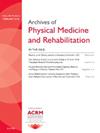Home-Based Balance Training on Balance and Mobility in Persons With Multiple Sclerosis: A Systematic Review and Meta-analysis
IF 3.6
2区 医学
Q1 REHABILITATION
Archives of physical medicine and rehabilitation
Pub Date : 2024-10-01
DOI:10.1016/j.apmr.2024.05.019
引用次数: 0
Abstract
Objectives
To (1) examine the effects of home-based balance training on balance and mobility outcomes; (2) evaluate comparable effects between home- and center-based balance training; (3) determine the effects of different levels of supervision on treatment effects; and (4) investigate dose-response relationships of home-based balance training on balance and mobility performance in persons with multiple sclerosis (MS).
Data Sources
Literature searches were conducted in MEDLINE, EMBASE, PsycINFO, SPORTSDiscus, and CINAHL in April 2023. Other literature sources included website and citation searches.
Study Selection
The study included randomized controlled trials of home-based balance training that included balance and mobility outcomes in persons with MS.
Data Extraction
Data extracted from each study included (1) number of participants; (2) dropout rate; (3) sex; (4) MS phenotype; (5) age; (6) Expanded Disability Status Scale (range); (7) exercise dose; (8) level of supervision; (9) type of intervention; (10) exercise progression; (11) type of control; and (12) outcomes measures. For the meta-analysis, mean and SD of the balance and mobility outcomes in both the intervention and control groups were used. The methodological quality of included studies was evaluated by Tool for the Assessment of Study Quality and Reporting in Exercise.
Data Synthesis
Eleven studies were identified in this systematic review and meta-analysis. Each balance and mobility outcome was standardized using Hedges’ g.
Conclusions
This meta-analysis revealed comparable results between home- and center-based balance training in terms of balance and mobility improvement. There was also no evidence for the superiority of home-based balance training over no training except for static steady-state balance. This study revealed that training sessions (>36 sessions) and total exercise time (>1100min) were significant moderators for overall balance improvements. Results also indicated that, when designing future interventions, at least an indirect level of supervision (eg, weekly or biweekly phone/video calls) is warranted to maintain adherence.
居家平衡训练对多发性硬化症患者平衡和活动能力的影响:系统回顾与元分析》。
目的1)研究家庭式平衡训练对平衡和活动能力结果的影响;2)评估家庭式平衡训练和中心式平衡训练的可比效果;3)确定不同程度的监督对治疗效果的影响;4)研究家庭式平衡训练对多发性硬化症(MS)患者平衡和活动能力表现的剂量-反应关系:2023 年 4 月在 MEDLINE、EMBASE、PsycINFO、SPORTSDiscus 和 CINAHL 中进行了文献检索。其他文献来源包括网站和引文检索:研究包括基于家庭的平衡训练随机对照试验,其中包括多发性硬化症患者的平衡和活动能力结果:从每项研究中提取的数据包括:1)参与者人数;2)辍学率;3)性别;4)多发性硬化症表型;5)年龄;6)扩展残疾状况量表(EDSS)范围;7)运动剂量;8)监督水平;9)干预类型;10)运动进展;11)对照类型;12)结果测量。在进行荟萃分析时,采用了干预组和对照组平衡和活动能力结果的平均值和标准差。纳入研究的方法学质量由 TESTEX 进行评估:本次系统和荟萃分析共确定了 11 项研究。每项平衡和活动能力结果均使用 Hedge's g 进行标准化:这项荟萃分析表明,家庭式平衡训练和中心式平衡训练在改善平衡和活动能力方面的效果相当。除静态稳态平衡外,没有证据表明在家进行的平衡训练优于不进行的训练。这项研究表明,训练次数(大于 36 次)和总锻炼时间(大于 1100 分钟)对整体平衡能力的提高有显著的调节作用。研究结果还表明,在设计未来的干预措施时,至少需要一定程度的间接监督(如每周或每两周一次的电话/视频通话),以保持训练的坚持性。
本文章由计算机程序翻译,如有差异,请以英文原文为准。
求助全文
约1分钟内获得全文
求助全文
来源期刊
CiteScore
6.20
自引率
4.70%
发文量
495
审稿时长
38 days
期刊介绍:
The Archives of Physical Medicine and Rehabilitation publishes original, peer-reviewed research and clinical reports on important trends and developments in physical medicine and rehabilitation and related fields. This international journal brings researchers and clinicians authoritative information on the therapeutic utilization of physical, behavioral and pharmaceutical agents in providing comprehensive care for individuals with chronic illness and disabilities.
Archives began publication in 1920, publishes monthly, and is the official journal of the American Congress of Rehabilitation Medicine. Its papers are cited more often than any other rehabilitation journal.

 求助内容:
求助内容: 应助结果提醒方式:
应助结果提醒方式:


